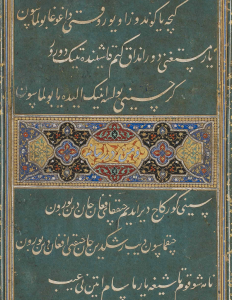
One of the many works of Persian calligraphy on display at the Freer Sackler Gallery.
There are many who see the foreign symbols of the Arabic alphabet as art themselves, in contrast to the bland letters of our own modern English alphabet. The sequences of curves and dots that make up the Arabic figures give it a creative nature. Historically, Persian calligraphers used flat-tipped pens, expertly constructing both thick and thin lines in Persian script to produce this artistic sense.
The Arthur M. Sackler Gallery, 1050 Independence Ave. SW, is currently holding an art exhibit called “Nasta’liq: The Genius of Persian Calligraphy,” which showcases the innate beauty of this alphabet. Nasta’liq is a calligraphic script that developed in 14th-century Persia. Originally a style of writing, nasta’liq has developed into an artistic expression of Persian culture.
The exhibit focuses on four of the most influential nasta’liq calligraphists who lived between the 14th and 16th centuries. The first is Mir Ali Tabrizi, the inventor of this script form.
Next is Sultan Ali Mashhadi, referred to as the “sultan of calligraphers” in gallery descriptions, who worked as a writer and a teacher and developed new, more technical rules of calligraphy.
His student Mir Ali Haravi became notable — surpassing the sultan himself, according to some historians — and produced large-scale qit’as (fragments of poetry). However, the authenticity of these manuscripts is unverified, as the Sultan allowed his pupils to sign his name on their own pieces, which already closely imitated his work.
Last, but certainly not least, the apparent master of nasta’liq is the last of the four to be presented. Mir Imad al-Hasani, a 16th-century man who is still regarded in Iran today as the greatest calligrapher, was interestingly murdered in 1615. Some experts claim that it’s possible he was assassinated under orders of a rival calligrapher named Ali Riza.
The nasta’liq exhibit is not large, featuring about 20 works and filling only two small rooms in the Sackler Gallery. However, with most of the gallery in transition between exhibits, this is one of only a few displays currently available to audiences. Its stated purpose is to describe the story of nasta’liq’s shift from a written form of communication to an artistic form of expression.
The exhibit includes a brief description of nasta’liq’s transformation as well as a short video of calligrapher Manzar Moghbeli writing characters with a traditional calligraphy pen and dipped ink. The video in particular helps the audience understand the difference between calligraphy and our own style of writing. Making this distinction can lead to a greater appreciation of the works themselves.
Additionally, a must-see feature of the gallery is a display case with several calligraphy pens from 18th- and 19th-century Turkey as well as an original white inkstand from 13th-century Persia inside the first room.
The first room of the exhibit features some historically relevant information concerning the birth of nasta’liq, such as a map of its origins, but it’s mainly dedicated to Mir Tabrizi’s important works as the founder of the art form. The pieces include pages of writing, typically stacked on top of one another. All the pieces are written on ancient parchment paper, but the black ink of the bold letters stands out aesthetically.
The next room features the other three master calligraphers in chronological order. The Sultan’s collection is first and primarily composed of folios that present his scriptures in the middle of green oriental-decorated pages. His style is notable for its balance between compressed and elongated strokes, with a variation between thinness and thickness. Next come Mir Haravi’s pieces, which favor more slanted and elongated strokes. Finally, a large section is dedicated to Mir Hasani, the ultimate master of nasta’liq. His folios are based on dark blue or green painted backgrounds. The writings are typically poems and include a few lines of script, surrounded by small illustrations and elaborate borders. English translations of the poems are given as well. Hasani’s writing is notable for its consistency and features six different cursive scripts of the time.
To bring the exhibit full circle, one last centerpiece features four original books, each of which is signed by one of the nasta’liq authors and again includes artistic backgrounds to the nasta’liq writings.
With only two very small rooms and approximately twenty pieces, it is probably not worth the long trip to the Smithsonian for students unless they hold a particular interest in Persian culture. Nevertheless, the exhibit provides a fascinating glimpse into the artistry of Arabic script and usage of writing as an art form. Having experimented with calligraphy pens a few times in the past, I personally enjoyed seeing such authentic and original pieces.
With free entry every day, anyone already in the area can easily stop by the Sackler Gallery for just 15 minutes to get a comprehensive look at all the works on display, leaving the exhibit with a sense of appreciation for the aesthetic appeal of calligraphy. The exhibit will run through March 22, 2015.


















